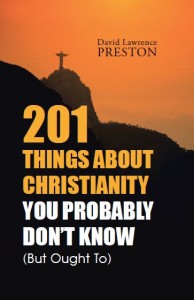Ten Easter Myths
Most leading historians, archaeologists and linguists don’t believe that the four official Christian Gospels can be relied upon as accurate records of historical fact. Indeed, the Easter stories are highly dubious as factual accounts, and they are the very basis of the religion.
Christians believe these stories because the gospels say they happened, or so they think. But most Christians aren’t aware of the inconsistencies in the scriptures. The gospels are riddled with factual errors, contradictions and unsupported statements that challenge the very basis of the religion.
This series presents ten myths about the Easter stories drawing on gospel sources and historical records from the period.
Myth #7: The Gospels’ accounts of Easter Day are accurate and consistent
Between them the gospels report dozens of sightings of the risen Yeshua, but their stories differ. Most began and ended mysteriously. Usually he ‘drew near’ then ‘disappeared from sight’.
- The First Gospel ended with the body missing and an angel telling the disciples to return to Galilee where they would see him. They were clearly not expecting this, and fled in terror.[1]
Decades later, twelve extra verses were added in which the Christ figure ‘appeared’ to them several times. He spoke to them and was immediately whisked away to heaven. The NRSV New Testament says in the footnotes that some authorities mark these verses ‘doubtful’. Nowhere does either the original author or the later contributor claim that Yeshua had risen in bodily form.
- In the Second Gospel, Mary Magdalene and another Mary encountered Yeshua by the empty tomb, but they didn’t recognize him. Clearly he wasn’t the man they remembered from just a few days earlier. He told them to tell the disciples to return to Galilee where they would see him. Several sightings are reported.
The writer adds an interesting postscript: the Jewish leaders, petrified of what would happen if the word got out that Yeshua had come back to life, paid the soldiers guarding the tomb to spread the story that the disciples came by night and stole the body while they were asleep. ‘This story is still told among the Jews to this day,’ he wrote fifty years later.[2]
- The Third Gospel added several more appearances in which Yeshua ‘came near’ and ‘stood among them’, showed them his wounds, ate fish, then vanished (there are no such claims in ‘Mark’ or ‘Matthew’). Later, he ‘withdrew from them and was carried up to heaven.’[3] All of this happened on Easter Sunday. None of these stories concurred with the other gospels. Moreover, far from fleeing to Galilee, the disciples stayed in Jerusalem and ‘were continually in the temple.’
- In the Fourth Gospel, Mary Magdalene discovered the empty tomb and went to fetch Cephas and ‘the disciple who Yeshua loved.’[4] They ran back to the tomb, then the two disciples ‘returned to their homes.’ (It’s not clear where these ‘homes’ were. It’s implausible that they had homes in Jerusalem). Mary then encountered two angels by the tomb who told her Yeshua had risen. She turned round and he was standing behind her, but she did not recognise him. He told her not to touch him because he had not yet ‘ascended to the Father.’[5] She then reported back to the disciples.
Later, says the author, he ‘stood among’ the disciples and invited ‘doubting’ Thomas to touch his wounds.[6] He also he appeared to the disciples on various occasions, once while they ate bread and fish for breakfast and one in which he appeared on a beach and gave the disciples some advice on fishing.[7]
- Acts of the Apostles, written by the same author as the Third Gospel, merely says he ‘presented himself alive’ to the disciples over a forty day period before the momentous events of Pentecost.
Once again we find ourselves wondering which, if any, of these accounts is correct, since they can’t all be right!
There seems little doubt that some of Yeshua’s followers felt the presence of their Master after his death and others thought they saw visions. We must not be too sceptical – it’s not unusual for bereaved people to ‘see’ a departed loved one or imagine they are around them. Their experiences, whatever they were, may have felt very real, because many of them later suffered and died for their faith.
But surely if a body had come back to life in a physical sense it would have been reported in the historical records of the day!
The only things the four gospels agree on is that the tomb was empty on the third day and Mary Magdalene was one of those who discovered it. None explains how Yeshua was encountered in the garden fully clothed, considering the burial clothes were left in situ.
The church likes to sweep aside the differences as if they don’t matter, but they do. They cast doubt on the accuracy of all four versions bearing in mind that none of the authors were eye-witnesses and at least forty years had passed before their accounts were written.
©David Lawrence Preston, 11.2.2017
Follow me on Facebook and Twitter @David_L_Preston
Balboa Press 2015
[1] Mark 16: 5-8
[2] Matthew 28:15
[3] Luke 24:50-51
[4] John 20:2
[5] John 20:17
[6] John 20:19-20
[7] John 21:4-6


Leave a Reply